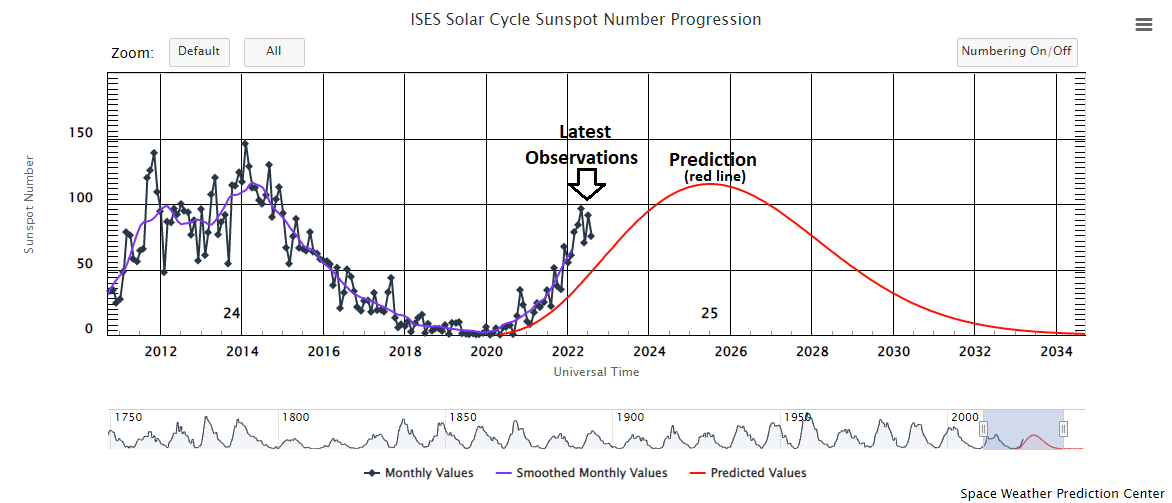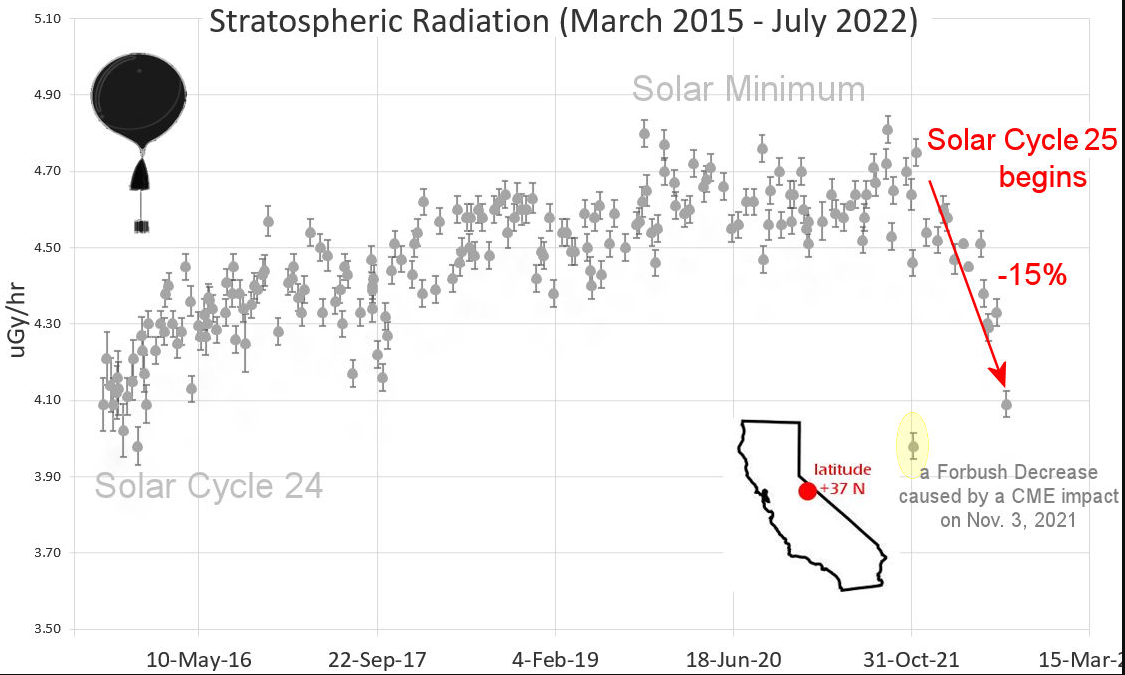7:15 AM | *An update on solar cycle 25 and its impact on cosmic rays*
Paul Dorian
The observed and predicted solar cycle is depicted in “Sunspot Number”, the black line represents the monthly averaged data and the purple line represents a 13-month weighted, smoothed version of the monthly averaged data. The forecast for the current solar cycle is given by the red line. Plot courtesy NOAA/Space Prediction Center
Overview
Solar cycle 25 began during late 2019 and is expected to continue until about 2030 with a peak around 2025. This current solar cycle is the 25th since 1755 when extensive recording of sunspot activity began. Sunspot activity has ramped up significantly since the beginning of cycle 25 featuring 57% spotless days in 2020, 18% in 2021, and only 1 day so far this year without visible sunspots. In fact, the start to solar cycle 25 has been somewhat surprising with more sunspot activity than most earlier predictions had suggested and this is having an impact on cosmic rays.
Daily observations of the number of sunspots since 1 January 1977 according to Solar Influences Data Analysis Center (SIDC). The thin blue line indicates the daily sunspot number, while the dark blue line indicates the running annual average. The recent low sunspot activity is clearly reflected in the recent low values for the total solar irradiance. Compare also with the geomagnetic Ap-index. Data source: WDC-SILSO, Royal Observatory of Belgium, Brussels. Last day shown: 31 August 2022. Last diagram update: 9 September 2022.
Solar cycle predictions
Solar cycle predictions are used by various agencies and industry groups and are very difficult as our overall knowledge of the sun is still rather limited. Many solar scientists would suggest, for example, that we really don’t have a good idea about what happens inside the sun. It is thought that the solar magnetic field is generated by a dynamo inside the star, a rotating, convecting, and electrically conducting fluid that converts kinetic energy into magnetic energy, spinning a magnetic field out into space around the Sun. Sunspots are thought to be related to the sun’s rotation and the solar equator actually rotates faster than the poles. If straight magnetic field lines running longitudinally were to be dragged along with this rotation, they would become stretched and eventually tangled, generating temporary, localized regions of strong magnetic fields, or sunspots.
Despite our limited knowledge of the sun, predictions are indeed made for solar cycle activity as, for example, they are important for determining the life span of satellites in low-Earth orbit, as the drag on the satellites correlates with the solar cycle. A higher solar maximum decreases satellite life and a lower solar maximum extends satellite life. Also, the prediction gives a rough idea of the frequency of space weather storms of all types, from radio blackouts to geomagnetic storms to radiation storms, so is used by many industries to gauge the expected impact of space weather in the coming years. The current solar cycle, 25, appears to be more active than the consensus prediction with more sunspot activity at this stage compared to many of the earlier predictions. For the month of August, for example, the sunspot number averaged 75.4 versus a predicted value of 48.4. There certainly is still a chance that solar cycle 25 ends up as another weak cycle with less sunspot activity compared to normal. If so, this would continue a recent trend that has featured weakening solar cycles since cycle 21 peaked around 1980.
Most high-energy radiation doesn't come from the sun; it comes from deep space. Every day galactic cosmic rays from distant supernova explosions pass through the Solar System. When they hit the top of Earth's atmosphere, they create a secondary spray of radiation, which we measure using sensors onboard our balloons. Measurements since the onset of solar cycle 25 show a 15% reduction in the atmosphere high over California. ((Courtesy spaceweather.com).
Cosmic rays
One of the ways to determine the stage of a solar cycle is to evaluate the level of cosmic rays that are reaching the Earth. Galactic cosmic rays from distant supernova explosions pass through the solar system and are high-energy particles that impact the Earth’s atmosphere. Most of the incoming cosmic ray particles are protons and they actually arrive as individual particles – not in the form of a ray as the term “ray” would suggest. Cosmic rays from deep space are repelled by solar activity; when one goes up, the other goes down. The sun makes it more difficult for these cosmic rays to reach Earth. Simply put, when the sun is active, its magnetic field gets stronger and more tangled. Cosmic rays have trouble penetrating the magnetic thicket. Also, individual coronal mass ejections (CMEs) sweep aside cosmic rays, causing sharp reductions called "Forbush Decreases."
One of the best ways to determine the influx of cosmic rays on Earth is to measure radiation levels high up in the atmosphere and atmospheric radiation levels in 2022 have been decreasing. In fact, measurements using “cosmic ray balloons” in the high atmosphere over California have shown a 15% drop in radiation levels since the early days of solar cycle 25 which is a 6-year low. These measurements are done on a regular basis through the use of balloons and are sponsored by “spaceweather.com” (more information here). The radiation sensors onboard the helium balloons detect X-rays and gamma-rays in the energy range 10keV to 20MeV (these energies span the range of medical X-ray machines and airport security scanners).
This finding of subsiding cosmic radiation is not surprising as the onset of solar cycle 25 – a cycle that is more active than anticipated - has naturally led to the decrease in cosmic radiation reaching the Earth. Solar maximum for cycle 25 is expected sometime during 2025, so the downward trend in cosmic radiation should continue for a few years to come.
Meteorologist Paul Dorian
Arcfield
arcfieldweather.com



